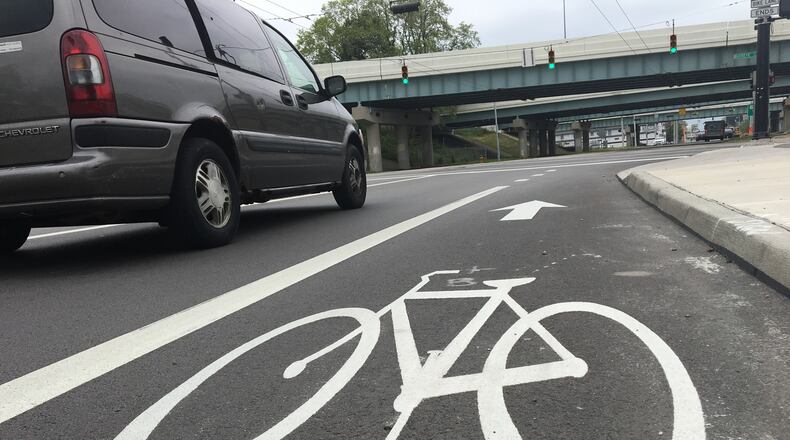“It can be a little scary (under U.S. 35) with all the ramps coming in,” said Joe Weinel, senior engineer II with the city of Dayton.
RELATED: Dayton could get a ‘high line’ elevated bike trail, like New York and Chicago
RELATED: Link, Dayton’s bike-share program, expanding
Bike lanes on Jefferson and St. Clair streets tie into the Great Miami River and Mad River trails at RiverScape MetroPark to the north.
But the bike path that heads south on St. Clair Street ends before Fifth Street. On Jefferson Street, the bike lane — which travels north — starts at Patterson Boulevard.
That leaves a 0.2-mile gap between the Jefferson Street bike lane and the one on Warren Street.
This is a headache for cyclists. Riding under the overpass can be nerve-racking, since traffic often comes from all directions and moves swiftly while departing or entering U.S. 35.
RELATED: City to rebuild Warren Street near hospital
“Going under U.S. 35 just doesn’t feel very friendly,” said Laura Estandia, Bike Miami Valley executive director.
But in about a year from now, the city of Dayton expects to go out for bid for a project to extend the bike lane at Warren Street up to Jefferson Street.
The project, expected to be completed by the end of summer of 2018, also will extend the St. Clair Street bike lane across Fifth Street and have it turn right onto Stone Street, behind the Neon theater.
The path will then take a left onto Jefferson Street to create a contra-flow bicycle lane, which means that riders travel in the opposite direction of vehicular traffic.
The city will use eye-catching green paint for safety to clearly indicate where bikes are to travel, officials said.
The project, expected to cost more than $600,000, is part of the Dayton-Kettering Connector trail, which runs all the way down to Stroop Road in Kettering, where it meets up with the Iron Horse trail. The city received nearly $470,000 in federal funding for the project, which comes through the Miami Valley Regional Planning Commission (MVRPC).
The project also will complete a walking corridor from Brown and Warren Streets to the Oregon Historic District, Fifth Third Field and RiverScape.
The project will make it easier for UD students to get to downtown to explore and enjoy its amenities, said Estandia.
More people likely will bike between the UD campus area and downtown once there is a dedicated bike path, since it will increase comfort levels with making the trip safely, she said.
“Having more infrastructure under there would be a huge help,” she said.
Right now, cyclists can use a pedestrian bridge to get to the southern sections of the city while avoiding the underpass, but it definitely takes more time, she said.
Dayton has become a lot friendlier for cyclists.
Link, the city’s bike share program, is celebrating its second anniversary. A new bike park is planned for Welcome Park, near UD Arena. And city continues to add bike lanes when it reconstructs major thoroughfares and strategically selected roadways.
Still, Estandia and other cycling advocates say there is more work to do to improve bike connectivity, especially along the river and on the bridges.
The city plans to add bike lanes that officials say will better connect downtown to the western and eastern neighborhoods and the amenities they contain, such as the 2nd Street Market.
About the Author
